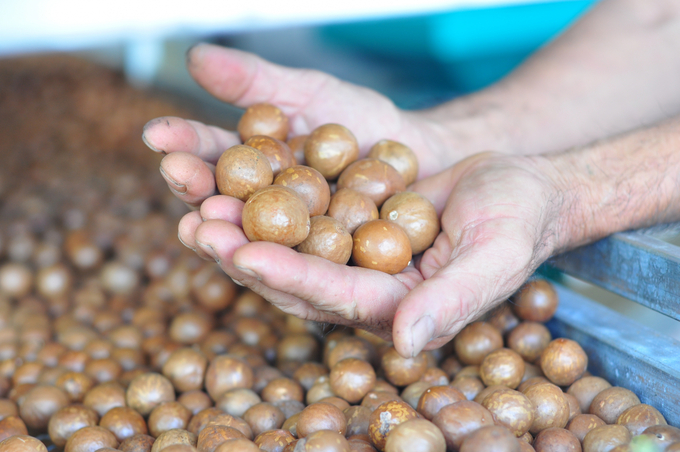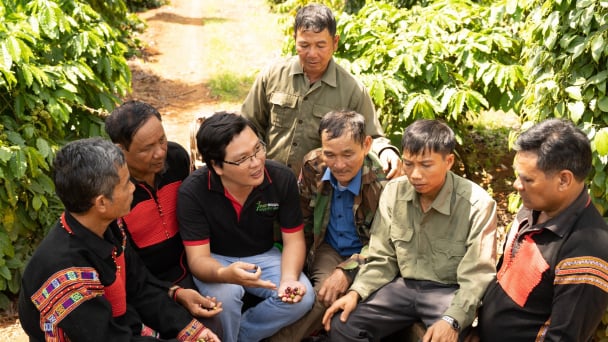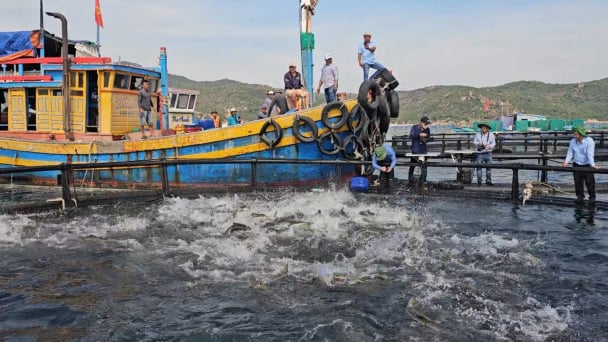May 24, 2025 | 16:24 GMT +7
May 24, 2025 | 16:24 GMT +7
Hotline: 0913.378.918
May 24, 2025 | 16:24 GMT +7
Hotline: 0913.378.918

Dam Rong district currently has about 1,200 hectares of macadamia. Photo: Minh Hau.
Many years ago, people in Dam Rong district (Lam Dong province) grew macadamia nuts locally. The total area of macadamia in the whole district is about 1,200 hectares and continues to be expanded. Of these 1,200 hectares, about 1,000 hectares are concentrated in two communes, Phi Lieng and Da K'Nang. In these two communes, the area entering the business stage is over 50 hectares, with an annual output of about 50 tons.
Mr. Nguyen Van Chinh, Head of the Department of Agriculture and Rural Development of Dam Rong district, said that locally, people produce macadamia through intercropping in coffee gardens and pure cultivation. People also use good-quality and high-yield varieties, such as QN1, 246, 695, OC, 788, 800, 816, 849, and A38.
Macadamia plantation models in Dam Rong district have increased income per unit area, diversified products, and reduced production and product consumption risks. In particular, the development of macadamia models has been opening the direction of sustainable economic growth for the locality.
The People's Committee of Dam Rong district recently issued a plan for the sustainable development of macadamia in 2022 - 2030, with a vision for 2050. Accordingly, Dam Rong district set a goal to make macadamia a valuable commodity with economic growth, creating jobs, increasing people's incomes, and developing the local agricultural economy, significantly contributing to the restoration and increase of forest cover.
"The district also aims to develop and expand the area of macadamia in association with the development of a chain linking production, processing, and product consumption. Towards building the OCOP product brand," said Mr. Tran Duc Tam, Vice Chairman of the People's Committee of Dam Rong district.
The district's goal is that by 2030, the total area of macadamia in the locality will reach about 2,849 hectares with a total output of about 2.3 thousand tons. The rate of cases of preliminary processing and processing will get over 90%. The orientation to 2050 is to achieve over 3.5 thousand hectares, an output of 4.7 thousand tons.
Dam Rong district plans to develop and expand the macadamia nut area on agricultural land in Phi Lieng, and Da K'Nang communes with a total area of over 2 thousand hectares by 2030. Of these, 153 hectares of net crops are planted and intercropped. 1.8 thousand hectares.

Dam Rong district focuses on building OCOP products associated with geographical indications for macadamia products. Photo: Minh Hau.
In these two communes, the agriculture sector of Dam Rong district also proposed a plan to grow macadamia to 2.3 thousand hectares by 2050. Along with the expansion of the area, the district also introduced varieties OC, 816, 900, QN1, and A38 varieties into production to improve productivity and product quality.
"The district also launched a plan to develop macadamia on the area of forest planning land that is stable agricultural production and land allocated to businesses. By 2030, it is expected that the area will reach over 800 hectares, and the orientation by 2050 is over 1.2 thousand hectares," said Mr. Nguyen Van Chinh, Head of the Department of Agriculture and Rural Development of Dam Rong district.
To achieve the set goals, the agricultural sector of Dam Rong district is embarking on the management of macadamia varieties. In particular, the organization closely inspects the production and trading facilities of macadamia nuts in the area to ensure the quality of the seed source. The district also organizes training to improve the capacity of enterprises, cooperatives, cooperative groups, farm owners, and farmers on macadamia production techniques.
Dam Rong district will establish community agriculture extension groups and groups to share and guide techniques for growing, caring for, harvesting, and processing macadamia. The district also organizes the integration of capital sources to support the construction and replication of the organic macadamia production model and the quality management and traceability model for farmers to learn and apply.
Simultaneously, Dam Rong district will build and develop linkage chains for macadamia production from the supply of seeds and materials, cultivation to harvesting, processing and product consumption. To attract enterprises to invest in building pre-processing and processing factories with modern processes and technologies to enhance the value of macadamia products. Focus on building OCOP products associated with local geographical indications for macadamia products and put these products to participate in fairs, exhibitions, product introduction and trade promotion to search and market expansion.
Mr. Tran Van Tuan, Director of Lam Dong Agricultural Extension Center, said macadamia trees had been locally grown since 2006. So far, the area of this tree in the province is over 5,000 hectares. Of these, the local business area of macadamia is over 1.6 thousand hectares, and the output of dried fruit is over 2.2 thousand tons.
Up to now, Lam Dong's macadamia production is gradually asserting its potential and strengths, contributing to increasing farmers' incomes, increasing land cover, and protecting the environment. Macadamia trees are progressively gaining a position in agricultural production in Di Linh, Lam Ha, Duc Trong, Bao Lam, and Dam Rong districts.
Translated by Ha Phuc

(VAN) South Korea is currently the second-largest investor in Hai Phong in terms of the number of projects (186 projects) and the largest in terms of total registered investment capital, reaching USD 14.2 billion.

(VAN) As consumers become more environmentally conscious, legal regulations grow increasingly stringent...

(VAN) CJ Feed&Care officially launched the FCR improvement campaign called “2025 Find Challenge Reach” in April 2025. In Vietnam, this campaign is implemented by CJ Vina Agri.

(VAN) The swamp in Pho Thanh is gradually being covered with red mangrove, creating a favorable environment for producing clean, high-quality salt.

(VAN) The trade turnover of agro-forestry-fishery products is growing significantly, along with investment cooperation commitments that are opening up new development directions between Vietnam and Russia.

(VAN) Khanh Hoa is investing over 545 billion VND to develop 240 hectares of high-tech marine aquaculture in order to guarantee a consistent supply of seafood exports and achieve the USD 1 billion target.

(VAN) Minister of Agriculture and Environment Do Duc Duy held a meeting with Soopakij Chearavanont, Chairman of C.P. Group, on May 15.